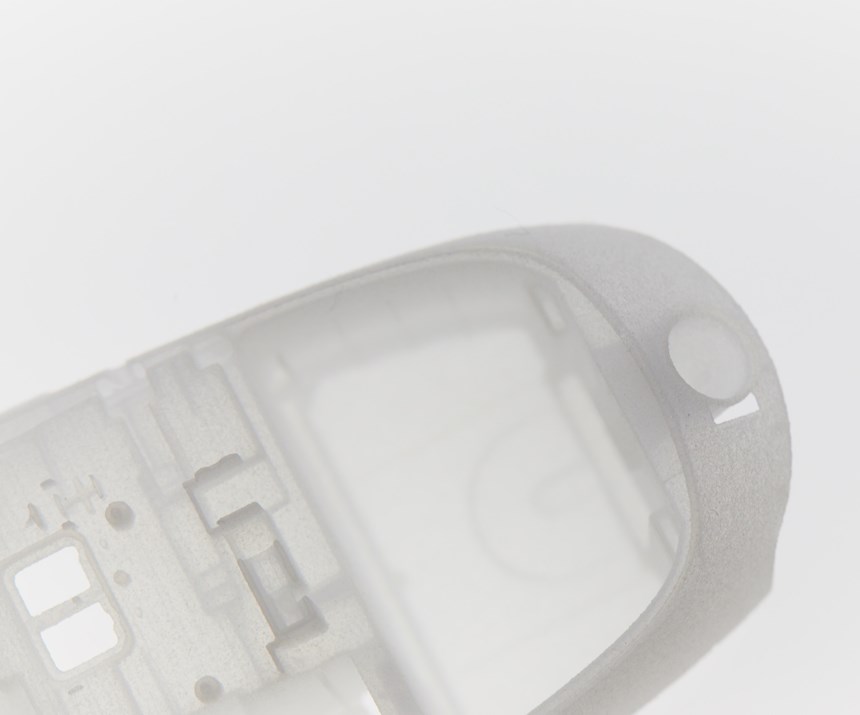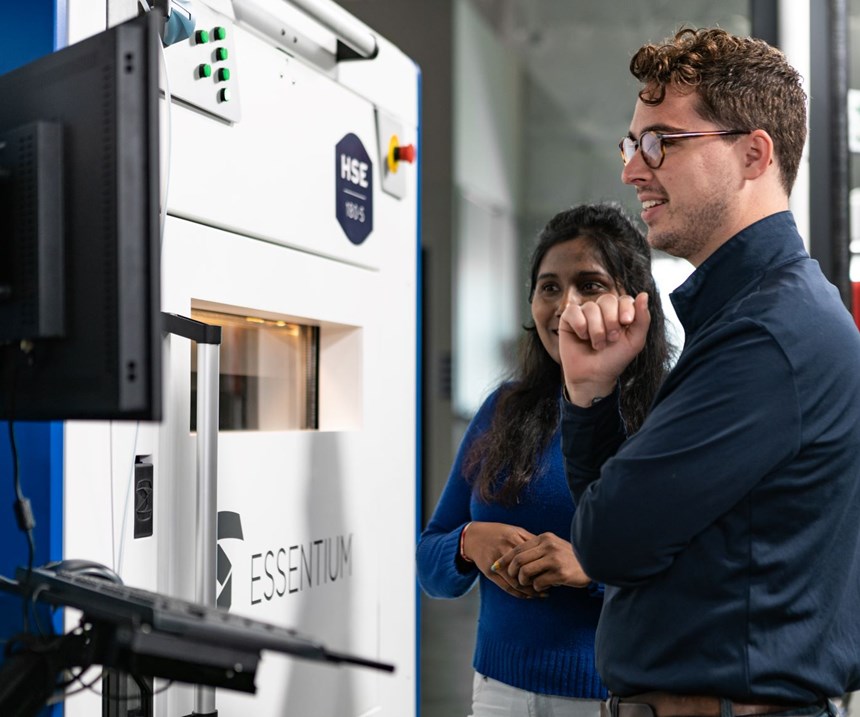Key Polymer Additive Manufacturing Highlights from Formnext 2019
Lots of new technology and advances from material and additive manufacturing system providers.
Another big-time exhibition and conference recently wrapped up in Germany. Formnext 2019 (Nov. 19-22; Frankfurt, Germany) is completely dedicated to the additive manufacturing industry, and there was a ton of news and technology announced at the show. Here are some of the highlights:
Covestro exhibited for the first time at Formnext, confirming its focus on the AM market. At Formnext, Covestro introduced a new brand for its 3D printing program, called Addigy, which offers customers added value by using customized materials in industrial production. Addigy offers a flexible material toolkit for large-scale industrial 3D printing, based on polyurethane, thermoplastic polyurethane and polycarbonate.

Covestro’s 3D-printed orthopedic insoles for shoes. They are produced from thermoplastic polyurethane (TPU).
Covestro also developed a special print head for additive manufacturing. The company says that thermoplastic films can be processed much more efficiently using 3D printing rather than filaments. The film passes through a cooled area into a heating zone, where it melts under the influence of the supplied thermal energy and becomes liquid. The melt is discharged via a defined nozzle geometry and processed into the product. The company believes the use of films will open up new possibilities for the combination of materials.
BASF introduced a new brand—Forward AM. The company says this new brand shows it continues to pursue its goal of driving industrial scalability as next phase of additive-based manufacturing. The company’s materials portfolio encompasses powder bed fusion, advanced plastic and metal filaments, and the latest photopolymers.
The BASF 3D Printing Solutions (B3DPS) portfolio will be complemented by an advanced flexible coating, which is well suited to flexible materials such as elastic Ultrasint TPU 01, developed in collaboration with HP for its Jet Fusion 3D-printer. The new coating can be used in special applications and will be available from Forward AM in black, white, metallic silver, and transparent.
Forward AM is also set to expand its thermoplastic Ultrafuse filament portfolio significantly, starting with the test-marketing of Ultrafuse TPU 95A, Ultrafuse ABS ESD and Ultrafuse PEI 9085. The company will be making sample volumes available as of January 2020, with larger volumes provided from the end of Q1 2020.
DSM showcased two materials innovations that it said can help bring it closer to its goal of sustainable manufacturing:
- A glass-reinforced PET material for fused granulate fabrication (FGF) printing, Arnite AM8527.
- The first PBT powder available for selective laser sintering (SLS), Arnite T AM1210 (P). The powder’s dielectric properties open the door to 3D printing applications requiring electrical insulation. It is recyclable and features a high reusability rate.
DSM also announced a partnership to develop custom and industrially scalable 3D printing solutions using Shapeways’ proprietary technology and digital manufacturing expertise and DSM’s materials.
Arkema is expanding its range of advanced materials for all major additive manufacturing technologies. N3xtDimension liquid resins are solutions for UV curable 3D printing with unique engineered resins and custom liquid resin systems. Three new resins launched at the show:
- High-temperature-resistant resin N3D T-1105
- Low-viscosity Casting resin N3D C-1115
- Impact modifier resin PRO22362
Arkema is enhancing thermoplastic range with the development of SLS Pebax powder. This partially bio-based thermoplastic elastomer for Selective Laser Sintering (SLS) reportedly provides the ideal combination of the usual strength of polyamides plus the flexibility and elasticity of polyethers/polyesters; ideal for sports applications.
Arkema is further supplementing its range of advanced polymers for filament extrusion printing technologies (Rilsan polyamide, Kepstan PEKK [polyetherketoneketone], and Kynar PVDF) with MMA resin-based filaments.
Clariant introduced a newly-developed fire, smoke and toxicity compliant 3D printing material. PA6/66- GF20 FR LS using Exolit flame retardant material is compliant with EN 45545-2, NFPA 130 (ASTM E162, ASTM E662) and SMP 800-C. This material was designed specifically for 3D printing to achieve ideal mechanical properties with a reported excellent flame retardancy, low smoke and low toxicity. Unique rail application parts were on display.
On the Systems Side
EOS showcased its Fine Detail Resolution (FDR) technology for processing polymers for the first time at formnext. EOS says it’s the first manufacturer to develop a solution for powder-based industrial 3D printing using a CO laser. This will make it possible to produce extremely delicate yet robust parts with fine detail resolution surfaces and minimum wall thicknesses of only 0.22 mm. It will open up new applications for series production.

These plugs were 3D-printed with the EOS FDR technology.
FDR is ideal wherever delicate structures, surfaces with a fine detail resolution and thin wall thicknesses are the foremost requirements. Unlike the existing EOS product range, a 50-watt CO laser is being used for this. This laser type creates an ultra-fine laser beam with a focus diameter that is half the size of current SLS technologies. This reportedly enables completely new exposure parameters resulting in parts that have superfine surfaces. Initially, the certified material PA 1101 is used. It is processed in layer thicknesses of 40 and 60 μm and features both high impact resistance and elongation at break. In addition, it is made from renewable raw materials.
Carbon’s largest format printer, the L1 printer, is available to order. With approximately 5x the build area of the Carbon M2 printer, the L1 printer provides new capabilities to fabricate bigger parts and also to manufacture many parts simultaneously, helping companies deliver innovative products and improve overall production efficiency. The Carbon family of production-ready materials, such as rigid polyurethane (RPU), elastomeric polyurethane (EPU), epoxy (EPX), and silicone (SIL) are compatible with the L1 printer.
Additionally, Jabil, will join the Carbon Production Network, further expanding access to the Carbon Platform. Healthcare applications leveraging the Carbon Digital Manufacturing Platform will be a central focus of the partnership.
HP announced a series of new subscriptions and services. The new HP 3D as a Service (3DaaS) Base subscription service provides customers automatic replenishment of HP 3D Supplies, simplified tracking of billing and usage, and reliable remote and on-site support services. The new pay-per-build service is available for the HP Jet Fusion 5200, HP Jet Fusion 4200, and HP Jet Fusion 500 series 3D solutions.
The new HP 3D as a Service (3DaaS) Plus subscription offering integrates hardware, supplies, and services and is ideal for customers looking to accelerate product life cycles with optimized in-house rapid prototyping and final part production. The initial 3DaaS Plus subscription starts with the HP Jet Fusion 340 solution, with additional 3DaaS subscriptions to be introduced.
Siemens and HP also showcased new serial production-ready parts designed with two leading automotive industry suppliers. Leveraging the recently announced HP + Siemens additive manufacturing solution, automotive engineering expert EDAG has developed a topology-optimized active coolant distributor for electric vehicles and Adient, a global leader in automotive seating for all major automakers, is creating a new seat headrest optimized for size and light-weighting without compromising material strength and flexibility.
Also, Lubrizol is announcing the availability of a new certified thermoplastic polyurethane (TPU) material for HP Jet Fusion 4200 3D printing solutions. The new Lubrizol TPU complements HP’s existing High Reusability PA-12, PA-12 Glass Beads, PA-11, and BASF Ultrasint TPU materials.
Essentium announced the expansion of its additive manufacturing platform with the introduction of high-temperature (HT) materials and new models of its Essentium High Speed Extrusion (HSE) Printing Platform. The nozzle temperature of the new HSE 180 S HT reaches 550°C and uses a wide variety of materials to produce parts that can withstand temperatures of 180°C.
Essentium also announced it will seamlessly integrate Materialise 3D printing Magics Essentials software with the Essentium HSE 3D Printer.
For more formnext news, check out show coverage from PT’s sister publication, Additive Manufacturing.
Related Content
Getting into Plastics Additive Manufacturing? Avoid these Six Common Errors
There are a lot of 3D printing technologies out there, and it’s not uncommon for processors new to additive manufacturing to get tripped up. Here are some typical snafus, along with advice on how to avoid them before you start making parts.
Read More3D Printing of Injection Molds Flows in a New Direction
Hybrids of additive manufacturing and CNC machining can shorten tooling turnaround times.
Read MoreMake Every Shot Count: Mold Simulation Maximizes Functional Parts From Printed Tooling
If a printed tool only has a finite number of shots in it, why waste any of them on process development?
Read MoreDaimler, OMIC Evaluate Wire-Fed DED for Moldmaking
3D printing a core and cavity on machine from Gefertec, followed by machining, allowed for a complete mold tool to be produced in three days.
Read MoreRead Next
Advanced Recycling: Beyond Pyrolysis
Consumer-product brand owners increasingly see advanced chemical recycling as a necessary complement to mechanical recycling if they are to meet ambitious goals for a circular economy in the next decade. Dozens of technology providers are developing new technologies to overcome the limitations of existing pyrolysis methods and to commercialize various alternative approaches to chemical recycling of plastics.
Read MoreProcessor Turns to AI to Help Keep Machines Humming
At captive processor McConkey, a new generation of artificial intelligence models, highlighted by ChatGPT, is helping it wade through the shortage of skilled labor and keep its production lines churning out good parts.
Read MoreHow Polymer Melts in Single-Screw Extruders
Understanding how polymer melts in a single-screw extruder could help you optimize your screw design to eliminate defect-causing solid polymer fragments.
Read More




































